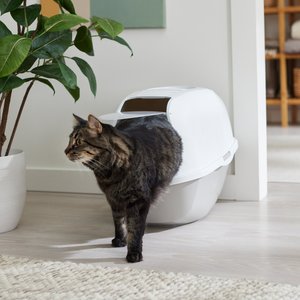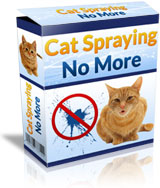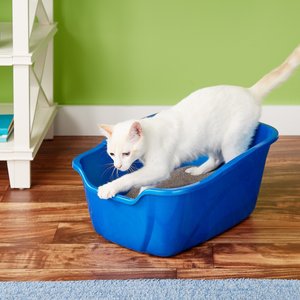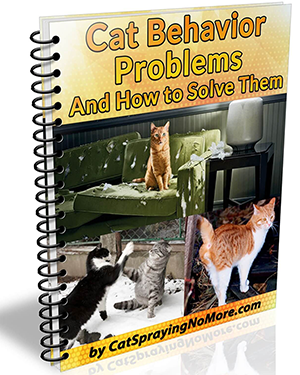Daily Archives: April 1, 2023
How to train an adult cat to use a litter box they don’t like
Cats are generally known to be fastidious creatures that are clean and well-groomed. They instinctively use a litter box to relieve themselves, making it easier for their owners to maintain a clean living space. However, there may be instances when your adult cat refuses to use a litter box they don’t like, making it a frustrating situation for pet owners. In this article, we’ll go through some tips and tricks to train an adult cat to use a litter box they don’t like.
Understanding the Reason for Avoidance
The first step in training a cat to use a litter box they don’t like is to identify the reason why they are avoiding it. There can be a few reasons why a cat may refuse to use the litter box, such as:
- Health issues: Your cat may be suffering from a urinary tract infection or another health issue that causes discomfort while using the litter box.
- Litter box issues: The litter box may not be the right size for your cat, or it may not be cleaned frequently enough.
- Environmental changes: If there have been changes in the household or the cat’s living environment, such as a new pet or a new home, your cat may be stressed and may refuse to use the litter box.
- Preference: Some cats may have a preference for certain types of litter or litter boxes.
Once you have identified the reason for the cat’s avoidance, you can take steps to address the issue.
Addressing Health Issues
If you suspect that your cat is avoiding the litter box due to health issues, you should take them to a veterinarian for a checkup. Your vet can diagnose and treat any health issues your cat may be experiencing, which can help to alleviate any discomfort your cat may be feeling while using the litter box.
Adjusting Litter Box Placement
 If your cat is avoiding the litter box due to its placement, you can try relocating the box to a more suitable area. Litter boxes should be placed in a quiet, private area where your cat can use it without interruption. Avoid placing the litter box near food or water, as cats prefer to keep their eating and elimination areas separate.
If your cat is avoiding the litter box due to its placement, you can try relocating the box to a more suitable area. Litter boxes should be placed in a quiet, private area where your cat can use it without interruption. Avoid placing the litter box near food or water, as cats prefer to keep their eating and elimination areas separate.
Choosing the Right Litter Box
The size of the litter box is essential to consider when training your cat to use it. A litter box that is too small for your cat may be uncomfortable, while a litter box that is too large may be difficult for your cat to access. The general rule of thumb is that the litter box should be one and a half times the length of your cat, from nose to the base of their tail.
Want to know more about litter boxes click here
If your cat is avoiding the litter box due to its size, consider investing in a new one that is more suitable for their needs. You can also try different types of litter boxes, such as ones with high sides or lids, to see if your cat has a preference.

Choosing the Right Type of Litter
Cats have different preferences when it comes to litter, so it may take some trial and error to find the right type that your cat likes. There are several types of litter available, such as clay, clumping, and silica gel litter. You can try different types of litter to see which one your cat prefers.
Introducing a New Litter Box
If your cat has developed a preference for a particular type of litter box, such as an open-top or covered litter box, it may take some time to train them to use a new one. You can introduce the new litter box gradually by placing it next to the old one and gradually moving it to a new location.
If your cat is avoiding the litter box due to its newness, you can try placing some of their old litter in the new box to help them adjust. You can also try placing treats or toys near the new litter box to make it more appealing and encourage your cat to investigate it.
Using Positive Reinforcement
 Positive reinforcement is an effective way to train your cat to use a litter box they don’t like. You can reward your cat with treats or praise every time they use the litter box correctly. This positive reinforcement can encourage your cat to continue using the litter box, making it a positive experience for them.
Positive reinforcement is an effective way to train your cat to use a litter box they don’t like. You can reward your cat with treats or praise every time they use the litter box correctly. This positive reinforcement can encourage your cat to continue using the litter box, making it a positive experience for them.
Punishing your cat for not using the litter box is not recommended as it can cause stress and anxiety, leading to further litter box avoidance.
Maintaining a Clean Litter Box
Cats are clean animals and prefer to use a clean litter box. If the litter box is dirty or has a strong odor, your cat may avoid using it. It’s important to clean the litter box regularly, at least once a day, and replace the litter every week.
If you have multiple cats, you should have one litter box per cat, plus one extra. This can reduce the competition for the litter box and make it easier for each cat to find a clean litter box.

Conclusion
Training an adult cat to use a litter box they don’t like can be a frustrating experience, but with patience and persistence, it can be done. It’s important to identify the reason for the litter box avoidance and address the issue accordingly. This can involve adjusting the litter box placement, choosing the right litter box and litter, and using positive reinforcement.
Maintaining a clean litter box is essential to ensure that your cat continues to use it. If you’re having trouble training your cat to use the litter box, consider consulting with a veterinarian or a professional animal behaviorist. With the right training and care, your cat can learn to use the litter box they don’t like, making it easier for you to maintain a clean and healthy living environment.
This content may contain links to products, software and services. Please assume all such links are affiliate links which may result in my earning commissions and fees.
Cat Spraying No More Review
Cat spraying no more is a comprehensive guidebook designed to help cat owners deal with the issue of cat spraying. This problem can be frustrating for both the cat and the owner and can lead to a strained relationship between them. However, the good news is that this problem can be resolved with the right techniques and strategies, and this is exactly what Catsprayingnomore.com offers.
 The guidebook is written by Sarah Richards, a cat behavior specialist with years of experience in helping cat owners solve their pet’s behavioral problems. The ebook is well-structured and organized, making it easy to read and follow. It is also designed to be user-friendly, with clear step-by-step instructions and helpful illustrations.
The guidebook is written by Sarah Richards, a cat behavior specialist with years of experience in helping cat owners solve their pet’s behavioral problems. The ebook is well-structured and organized, making it easy to read and follow. It is also designed to be user-friendly, with clear step-by-step instructions and helpful illustrations.
The book begins by explaining the reasons why cats spray, including territorial marking, anxiety, and stress. It then goes on to provide an in-depth analysis of each of these causes, along with practical tips on how to identify them in your own cat. This section is particularly helpful, as it helps the reader understand the underlying reasons for their cat’s spraying behavior.
One of the standouts features of Catsprayingnomore.com is the emphasis on prevention. Sarah explains that preventing the problem from occurring in the first place is much easier than trying to solve it once it has developed. She provides practical advice on how to create a calm and stress-free environment for your cat, including tips on litter box placement, environmental enrichment, and how to create a routine. This was especially helpful for me and my cat.
What I got out of Cat Spraying No More and my review.
Note I had this problem when I moved to my current residents, I have moved with my cat and it seems like he did spray out of his little box because he wanted to mark his territory against the other cat that my roommate had. He would pee on things he knew what was mine, in this email book it gave me good strategies to overcome this.
The next section of the book focuses on the various methods that can be used to stop cat spraying. This includes both natural remedies and products that can be purchased from pet stores. Sarah provides a thorough analysis of each of these methods, along with their pros and cons. This information is helpful for the reader to make an informed decision about which method to use.
Overall, Catsprayingnomore.com is an excellent resource for any cat owner struggling with the problem of cat spraying. The book is well-written, easy to follow, and provides a comprehensive overview of the problem and its solutions. It is clear that Sarah Richards is an expert in this field, and her knowledge and experience shine through on every page of the book.
Other Reviews of Cat Spraying No More
“YOUR TECHNIQUES HAVE WORKED AMAZINGLY WELL”
 “I adopted Tigger from a rescue home 18 months ago. I tried everything to try to encourage him to wee in the litter tray but nothing I did worked – until a friend showed me your website! I am so grateful for the work you have put in here Sarah. Your techniques have worked amazingly well. Tigger hasn’t weed outside the little box for weeks now. Long may it continue!”
“I adopted Tigger from a rescue home 18 months ago. I tried everything to try to encourage him to wee in the litter tray but nothing I did worked – until a friend showed me your website! I am so grateful for the work you have put in here Sarah. Your techniques have worked amazingly well. Tigger hasn’t weed outside the little box for weeks now. Long may it continue!”
Barbara Grayson & Tigger – Leamington Spa, UK

“I WAS AMAZED AT HOW QUICKLY IT WORKED!”
 “My mom and dad were going crazy and about to give our cat away because of her constant peeing and spraying. The house smelt horrible and they didn’t have a clue how to stop it. I love Winnie and couldn’t bear to give her up so I promised I would help. I found Sarah’s website and told my mom about it. She said if this didn’t work, that was it. She’d have to give her away. But it did! I was amazed at how quickly it worked, and how easy the methods were to put into practice. It’s now been 2 months and Winnie hasn’t gone outside the litter box at all. Thank you so much Sarah!”
“My mom and dad were going crazy and about to give our cat away because of her constant peeing and spraying. The house smelt horrible and they didn’t have a clue how to stop it. I love Winnie and couldn’t bear to give her up so I promised I would help. I found Sarah’s website and told my mom about it. She said if this didn’t work, that was it. She’d have to give her away. But it did! I was amazed at how quickly it worked, and how easy the methods were to put into practice. It’s now been 2 months and Winnie hasn’t gone outside the litter box at all. Thank you so much Sarah!”
Shelley Davison & Winnie – Florida, US

“I WOULD HAVE HAPPILY PAID HUNDREDS OF DOLLARS FOR THIS!”
 “Bravo Sarah! I had no idea just how simple it was to coax Arthur back to his litter box, and most of all, STOP him from peeing anywhere else in the house! It all started when we moved house 6 months ago and I’ve been at a loss as to what to do. I’ve received all sorts of ‘expert’ advice from vets, and none of it has worked. These techniques have been so easy to implement, and so cheap too! I would have happily paid hundreds of dollars for the peace of mind that this guide has given me.”
“Bravo Sarah! I had no idea just how simple it was to coax Arthur back to his litter box, and most of all, STOP him from peeing anywhere else in the house! It all started when we moved house 6 months ago and I’ve been at a loss as to what to do. I’ve received all sorts of ‘expert’ advice from vets, and none of it has worked. These techniques have been so easy to implement, and so cheap too! I would have happily paid hundreds of dollars for the peace of mind that this guide has given me.”
Beverley Wyatt & Arthur – New Jersey, US

“THESE TECHNIQUES HAVE BEEN AN ABSOLUTE GODSEND”
 “I love my cat Bruno but I was struggling to cope with his behaviour. Whenever I would get home from work I would have to spray and mop the kitchen floor and then check all around the house for anything else he might have done. I was lucky if the cleaning took me less than 30-40 minutes. This set of techniques have been an absolute godsend. Bruno seems so much happier, and I definitely am! I really cannot thank you enough.”
“I love my cat Bruno but I was struggling to cope with his behaviour. Whenever I would get home from work I would have to spray and mop the kitchen floor and then check all around the house for anything else he might have done. I was lucky if the cleaning took me less than 30-40 minutes. This set of techniques have been an absolute godsend. Bruno seems so much happier, and I definitely am! I really cannot thank you enough.”
Lucy Benjamin & Bruno – Essex, UK
If you’re struggling with cat spraying, I highly recommend getting this Cat Spraying No More ebook.
